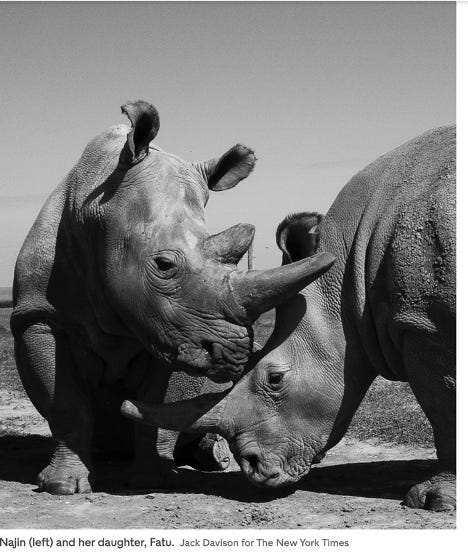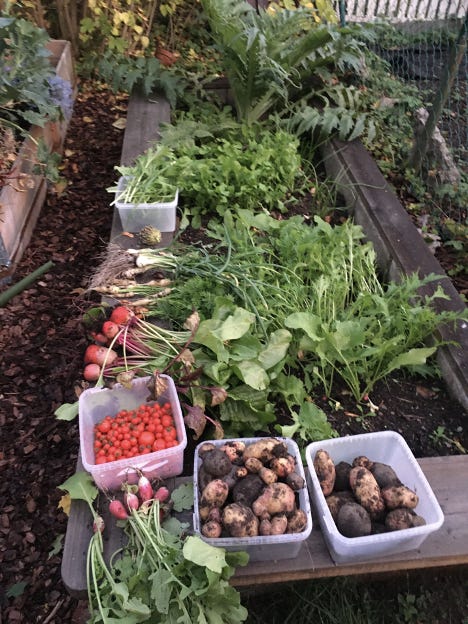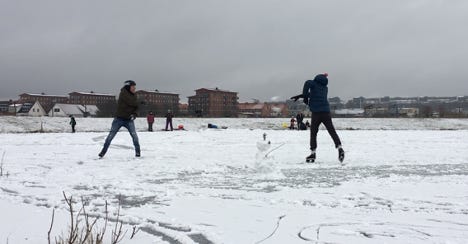Climate fact-check: Binge-watch all you want, but skip the Uber
Streaming is a pretty low-carbon pastime; Uber brings more cars to cities; standing close enough to hug extinction; what will you grow this year?
Welcome, friend!
Welcome to the first edition of We Can Fix It, your personal monthly guide from your favorite climate scientist for facing the climate crisis with facts, feelings, and action. I’m glad you’re here!
As a reminder, here’s the game plan for this newsletter.
OK, we’ve got a climate to fix, let’s get down to business!
Fact check: Netflix is fine for the climate; Uber, not so much.
Recent analyses correct two popular misconceptions, namely that:
(1) streaming content online is a climate villain (nope!) and
(2) Uber is somehow going to save the world (sorry, no).
The first analysis finds that the total climate impact, or carbon footprint, of streaming online content has been widely overstated.
International Energy Agency analyst George Kamiya writes in CarbonBrief that most energy use depends on the viewing device. Big TVs use more energy than smaller screens or devices. And energy use = climate pollution, until we transition to 100% clean energy.
But streaming Netflix actually has a tiny carbon footprint, independent of device. On average, streaming 30 minutes is equivalent to the climate pollution from driving a conventional car for a few seconds, the length of a football field.
Let’s say you wanted to watch a 2-hour film, and were choosing between streaming it at home, or driving 3 miles (5km) to a theater and back. You could watch the movie over 50 times at home for the carbon cost of the drive alone. (Note, I do not recommend watching any movie 50 times! Well, maybe my totally-not-guilty annual holiday pleasure Love Actually, but not 50 times consecutively!)
Fast-growing digital services don’t get a free climate pass; every sector needs to stop producing climate pollution.
But for you as a consumer, the bottom line is, it’s WAY less climate polluting to meet or entertain yourself online than driving or flying to do so. That means you should spend way more climate effort focused on your driving habits than your streaming ones. Speaking of which…
People buy more cars after ride-hailing services Uber and Lyft come to their city.
That’s the conclusion of a team of researchers in a study published in the peer-reviewed journal iScience earlier this month.
J Michalek, a coauthor of the study, wrote on Twitter that they analyzed the effect of Uber and Lyft on car use in 224 cities in the US. The authors were able to attribute the changes observed to Uber and Lyft, rather than other factors, because the companies entered the studied cities at different times.


These data alone can’t establish the reason why Uber/Lyft caused an increase in cars. Still, Michalek speculates people who own cars keep them, plus take additional trips by car with Uber/Lyft, whose drivers buy more cars.
The study also found that Uber and Lyft displace transit, that is, people shift away from subways and buses to cars.
More cars = bad climate news, because transport (mostly cars) is the largest source of climate pollution in the US, and a large and growing share in Europe. Nearly all cars still run on climate-destroying fossil fuels.
To avoid catastrophic climate change, we have to make all cars fossil-free. But technical improvements alone, like switching from fossil to electric cars, won’t be enough.
In car-dependent countries, as climate-crushworthy transport researcher Costa Samaras says, we need to “move more and drive less.”
On that note: I’m looking for best practices from cities around the world that have successfully reduced car use. This is part of my research project to radically, collaboratively reduce climate pollution in the municipality of Lund, where I live. Here are some inspiring suggestions I received so far.
If you know of any cities centering people not cars, please hit reply and tell me about them. Thanks!
Feelings: Love, Grief, and the Last Two Northern White Rhinos On Earth
It took me a really long time to realize that climate and ecological grief is a thing. But at this point, people and places I love have already been harmed by climate change and impoverished by biodiversity loss. I’ve found that acknowledging these losses is essential, both to honor what I value, and to fight for what’s left.
An important part of facing grief is to look it in the eye, not to turn away or to become numbed by statistics.
It’s one thing to read the 2019 global biodiversity assessment warning one million species are now threatened with extinction. (That’s about one in eight of the creatures we share the planet with. Yikes.)
It’s quite another thing to feel a personal connection with one of these threatened creatures. Feeling this connection is vital, though, because we are motivated to act to protect and care for what we love.
Sam Anderson’s incredible essay, “The Last Two Northern White Rhinos On Earth,” personalizes extinction through the story of Najin and Fatu, mother and daughter rhinos now peacefully living out their days in a wildlife conservancy in Kenya.
Over a week-long visit, Anderson connects deeply with “the girls.” He’s allowed to stand close enough “to see that their ears were fringed with a rim of hairs that seemed as delicate as eyelashes.” He was awed by the mass of the second-largest land mammal. A whole carrot “looked like a little orange toothpick” clamped in its big boxy rhino mouth.
He paints a picture of two specific individuals, who are well cared for and protected and loved. They don’t know they’re doomed as they enjoy the creaturely pleasures of a sunrise, a good back scratch, and cuddling with a loved one.
Like all creatures, the rhino does not exist in isolation; it is part of the web of life. Anderson writes, “A rhino is not just a part of the world — it is a world.” Their dung feeds insects who feed birds who feed predators.
Najin and Fatu are not just ambassadors for the abstract concept of a species, but individuals living singular lives. They are lives in the process of being snuffed out, by both the “acute violence of hunting…. [and] the chronic violence of habitat loss.” Anderson writes he “could not get enough of watching them sleep,” because, “Every time the girls closed their eyes, all the northern white rhino consciousness left on planet Earth temporarily blinked out.”
To get a feeling for the lives at stake in the biodiversity crisis, listen to the gorgeous audio version of the full story, narrated by Edoardo Ballerini. Bring Kleenex.

Action: Spring is Coming. Grow Something Delicious
Land use, primarily agriculture, causes almost a quarter of all climate pollution, and is the biggest driver of the biodiversity crisis.
In a 2017 study, Seth Wynes and I showed eating a plant-based diet is the most effective action to reduce your food’s climate impact. It’s also the biggest step to save water, land, and biodiversity.
There’s no better way to incorporate more delicious plants on your table than to grow what you can yourself. Always but especially over the last year, it is a pleasure to be out in the sunshine with your hands in the dirt, listening to birds singing and insects buzzing and watching things grow.
As spring shoos away the short, dark, and dreary days in Sweden, it’s time for my husband Simon and I to start planning our veggie garden.
Last year, we put a lot of work into our allotment garden, which was super satisfying. With design help from a landscape architecture student, and labor and craft help from a gardener, we removed the cement patio tiles foolishly taking up the sunniest corner of the garden. We built three big raised beds: one from the reclaimed cement tiles, and two cheap and simple stacked wooden pallet planters. For weed suppression, we lined the paths with two layers of cardboard donated from a local store, topped with wood chips. We filled the beds with horse manure (a gladly-given gift from a local riding arena) and compost. Then we planted seeds and seedlings, and the magic started.
Every time we came to the garden we’d make a round to exclaim over what was different this time. We’d find new cucumbers hiding amidst the far-too-small trellis we’d given it, not believing such a tiny seedling would ever command so much vertical real estate. (We’re still enjoying the pickles Simon made from his mom’s tried-and-true recipe.)
Even with a late start on planting, it was astounding what delicious bounty we harvested over the year. First were the radishes, followed by fresh green peas, chard, and carrots. Fall brought onions, potatoes, beets, and startlingly massive pumpkins, a second crop of spicy mizuna, and so many variations on cabbage (kale, Brussels sprouts, broccoli…).
What do you want to grow this year? Let me know, and take some inspiration below.
Action Menu:
If you have a garden (or can upgrade your lawn to an edible landscape):
Order seed catalogs and plan your garden. (We’ll order from this heritage seed association in Sweden. In the US, try heirloom seeds from Seed Savers Exchange.)
Plant things you enjoy eating, try a few new ones, add some flowers to make yourself and the pollinators happy.
For gardening inspiration, read Animal, Vegetable, Miracle by Barbara Kingsolver.
If you don’t have a garden, or access to a neighbor’s, look for ways to:
Join or start a community, school, or allotment garden.
Grow herbs or tomatoes in the windowsill or on a balcony.
Check out guerrilla gardening to convert unloved city corners to thriving gardens (here’s a lovely one in a former parking space in Copenhagen).
Harvest local food (my former student Kyle Clark made this list of initiatives to plant, harvest, and map urban fruit and nut trees).
Support farmers who take care of the land, starting in your foodshed:
Look for “community supported agriculture” + your town to find a local, sustainable farmer to support. (We’ll renew our veggie box subscription with my former student Kerstin).
Support farming and food cooperatives. (We get organic grains, greens, and more through our local food cooperative, and locally produced specialty items delivered by bike from the Mylla collaborative).
Happy growing and eating!
Parting Thoughts & Tidbits
“What does it feel like to be a climate scientist at the end of 2020?”
Listen to my conversation with my good friend Denise Young (hi Denise, We Can Fix It Subscriber #6! ❤️ ) on her New Climate Capitalism podcast about my terrifying experience of the California wildfires, my increasing ventures beyond the ivory tower, and my complicated relationship with climate hope.
Good Climate News:
The US is back in the Paris Agreement, the world’s framework for stopping climate heating. I got to witness the adoption of the Paris Agreement in December 2015 from the front row of observers. I’m a big fan.
Recently Enjoyed:
Read: All We Can Save: Truth, Courage, and Solutions for the Climate Crisis, edited by Ayana Elizabeth Johnson and Katharine Wilkinson. A diverse and much-needed collection of essays and poems highlighting the contribution of women leading climate action. I’ve posted my highlights on Goodreads.
Eat: The best falafel I’ve ever had was Simon making Kenji’s recipe from Serious Eats.
Drink: Golden milk (super cozy blend of oat milk with coconut oil, turmeric and black pepper).
Move: Ice skating on the local pond (my first time beyond a rink!!) was wobbly-ankle’d magic. Skates borrowed for free from our awesome sports equipment library.
See you in February!
Thanks for reading! I’d love to hear what you thought. Reply to this message with any feedback, or leave a comment below. (Have no fear, We Can Fix It is going to be that rare internet glen with a thoughtful and engaging comment culture.)
If you liked this newsletter, please share with a friend who’d enjoy it too. Thanks!
If someone forwarded you this newsletter, you can sign yourself up and get your very own edition next month!








Well done! Really enjoyed this newsletter. It's diverse and accessible.
I might not appear in your stats, but I subscribed via RSS. Looking forward to the next one!
Very nice newsletter Kim! Looking forward to next one :)